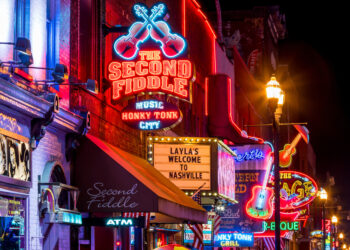New Orleans: it’s a city that gets under your skin. From the minute you arrive – sweaty in the humid heat, possibly pissed off and tired (as we were, after an agonising nine-hour drive through wind and torrential rain) – it steals a little piece of your heart and never lets it go. Here I won’t show you a list of places to visit in New Orleans for sightseeing etc. I will show you where to get the best food!
New Orleans is a city that crackles and spits: a melting pot of magic and vibrancy and sweet, sweet music. It’s a city that gets under your fingernails, grubby and familiar and alien. It’s a city quite visibly bruised after the devastation that Hurricane Katrina left it in almost fifteen years ago. But it’s a city with a dark and witty sense of humour, evident in the names of the cocktails (‘The Hurricane’ and ‘Category 5’ proving the most popular amongst both locals and tourists) sold along the streets.
Affiliate Disclaimer: Our blog posts may contain affiliate links. If you make a purchase through these links, we receive a modest commission at no extra cost to you. These commissions help us fund our team of travel writers, allowing us to continue providing you with the latest travel news, tips, and inspiration. Your support keeps this blog alive and thriving, and we appreciate it immensely. Thank you!
Places to visit in New Orleans to taste po’boys, gumbos & everything in between
Above all else, New Orleans is a city that celebrates food – and like the city, the food available in New Orleans draws its influences from the diversity of its inhabitants. That is a city full of soul.
The food native to Louisiana (New Orleans in particular) is typically described as Cajun or Creole food. Although these terms are often interchanged – Cajun food is often indeterminable from Creole food on many modern NOLA restaurant menus; the two cuisines are hugely different to those who know these sorts of things.

While many ingredients are similar, the differences between the cuisines lie in the finite details. For example, in Creole food, you will find tomatoes but in authentic Cajun food you won’t: that’s the easy way to tell the difference between the two when eating gumbo or jambalaya.
But onto the particulars: when visiting New Orleans, there are certain dishes that it would be a travesty not to try, and it was these dishes made my trip there extra special. So here’s my guide to the traditional food of New Orleans (including the restaurants you should visit to eat them).
Po’Boys
There are many modern variations on the po’boy, but the authentic New Orleans sandwich originated during the Great Depression streetcar strike some 100 years ago, composed of roast beef gravy and cut potatoes. That’s it. Nowadays, you can get po’boys stuffed with fried shrimp, alongside the French fry and gravy po’boys that are still sold on many menus (think a pimped up chip and gravy butty) oysters, soft-shell crab, catfish and roast beef.
Contrary to many other sandwiches out there, the bread is the most important part of the po’boy: anything other than perfectly cooked – crispy on the outside with a soft, doughy middle – French bread won’t do for the perfect New Orleans sandwich.

Similarly, a po’boy ain’t a proper po’boy without the “fixin’s”, so make sure that you order these dressings when you choose your sandwich and won’t be disappointed. Hot sauce, lettuce, mayo, salad, and pickles combine with your chosen filling (my personal favourite is the fried shrimp) to make one of the finest sandwiches you’ll ever eat.
Places to visit in New Orleans for po’boys:
If you like your food fancy, you’ll want to visit Mahony’s Po Boys. They’ve won numerous awards for their gourmet po’boys, including the Best Speciality Po’Boy in 2009 with its chicken liver and Creole slaw po’boy.
Take a trip to Johnny’s for a great ‘no frills’ po’boy in the French Quarter. The menu includes all the usuals and one special, the alligator po’boy.
Jambalaya
Not to be confused with its Spanish cousin paella, jambalaya is a rice dish comprised of various ingredients, including chicken, sausage, seafood, or any mixture. As mentioned above, it’s possible to tell the difference between a Cajun and a Creole jambalaya by whether or not it includes tomatoes – Creole jambalaya will (and will therefore have a more red appearance) and Cajun jambalaya will not.

Jambalaya is probably the most simple Nawlins dish to perfect – to make the perfect jambalaya, you should add all the ingredients to a pot in stages and then simmer for twenty minutes to an hour until ready. Et voila.
Places to visit in New Orleans for jambalaya:
K-Paul’s Louisiana Kitchen serves an outstanding Cajun jambalaya – it’s glorious comfort food at its finest.
Gumbo
The first time we ever tried to cook a gumbo in our tiny kitchen didn’t go well. We’d gone out that morning to purchase all of the ingredients necessary (and by all the ingredients, I mean ALL OF THE WORLD’S INGREDIENTS – a whole damn lot goes into making a proper gumbo) and started to assemble the dish at around 6pm. At around 10pm, we sat in front of bowls containing gelatinous pond sludge. It was also inedible. Glumly, we ordered pizza.
So you can understand why now, when anything goes wrong in our kitchen, we call it a ‘gumbo’—cooked the chicken to within an inch of its life? You’ve made a gumbo and burnt the potatoes? It’s a gumbo. You get the idea…

A proper gumbo should be anything but gelatinous pond sludge. It should be a fragrant, spicy, exciting stew over rice, seasoned with sassafras and bay leaves. Anything (and everything!) goes into a gumbo: chicken, ham, sausage, seafood. At first, the one ingredient I didn’t get on with was okra, a vegetable that takes on a slimy texture when cooked. It should be added, but be careful how you do it.
Places to visit in New Orleans for gumbo:
Li’l Dizzy’s Café is a family-run joint that serves up hearty and traditional New Orleans fare, including the famous gumbo. You don’t have to worry about this gumbo ever turning out bad – the Creole gumbo served at Lil Dizzy’s is the same recipe that has been in the family for decades, and the busy restaurant is a testament to its deliciousness.
Crawfish Boil and Crawfish Étouffée
Crawfish are EVERYWHERE in New Orleans. The crawfish boil is most closely associated with the city – the crawfish are put into a pot with a filter, and seasonings such as crab boil packets, cayenne pepper, salt, lemons, hot sauce and a bay leaf are often added. It’s not uncommon to see people shucking crawfish by the side of the roads – red shells (including the heads and the clippers) in one pot, cooked crawfish in another. Experiencing a crawfish boil is a must if you visit the Big Easy, and most restaurants will satisfy your cravings.
Crawfish étouffée is another authentically New Orleanian way to sample the city’s favourite shellfish. The crawfish is added to a thick stew – similar to a gumbo – but made with a white roux, which gives it a lighter colour and a different flavour.

Places to visit in New Orleans for Crawfish Boil and Crawfish Étouffée:
Many people will tell you that the best place to try an authentic Crawfish Boil is in a person’s home. Unfortunately, for travellers like you and I, it isn’t always possible to make friends with the locals and be invited round to their houses in the short time you’re in the city. Visit jean Seafood in Mid City for some takeout boiled crawfish and take it to City Park or the bayou for that real authentic taste of New Orleans.
For the freshest crawfish étouffée, visit Bon Ton Café. It’s not the cheapest restaurant in New Orleans, but the food is good, honest and traditional (and the crawfish tails are NEVER frozen).
There are so many fabulous food places to visit in New Orleans. Do you have any favourite restaurants you visit for the classics? I’d love to hear about them.











